Abstract
A composite composing of TiO2 nanoparticles load on biomass rice husk (RH) is developed by directly growing TiO2 nanoparticles on RH. The in-situ growth of the nanocrystals on RH is achieved by a low-cost and one-step homogeneous precipitation. Rapid hydrolysis proceeds at 90 °C by using ammonium fluotitanate and urea to facilitate the selective growth of TiO2. The method provides an easy access to the TiO2-RH composite with a strong interaction between TiO2 nanoparticles and the underlying RH. The structure and composition of TiO2-RH are characterized by using X-ray diffraction, X-ray photoelectron spectroscopy, Fourier-transform infrared spectroscopy, and UV-vis absorption spectroscopy. TiO2 nanoparticles-RH exhibits a good photocatalytic degradation of methyl orange. The results show that 92% of methyl orange (20 mg L−1) can be degraded within three hours in visible light. The catalytic activity of the composite is not reduced after 6 cycles, and it still reaches 81% after 6 cycles. The enhanced performance is ascribed to the suitable particle size the good dispersibility. It is expected that the high photocatalytical performance and the cost-effective composite presented here will inspire the development of other high-performance photocatalysts.
1. Introduction
Photodegradation of organic pollutants has received many interests during the past decades [1]. Titanium dioxide is distinguished and widely studied as a semiconductor photocatalysis [2,3]. It has been considered a promising catalyst because of its non-toxicity, cheapness, stability and high reactivity [4], and it has been used for removing environmental pollutants in air or water [5,6]. In recent years, organic/inorganic composites are used as catalysts, sensors, etc [7,8,9]. Some reports display that the TiO2-based composites show improved catalytic activities [10,11,12,13].
Methyl orange (MO) is a common acid-anionic mono-azo dye which contains an azo group (-N=N-). MO is used widely in printing and dyeing industries. The release of MO is harmful to the environment. As a result, the removal of MO in the industrial waste water has been of the most important tasks. As a represented azo dye, MO has been employed as a simulated target for photocatalytical measurements [14].
Biomass waste is a kind of cheap and easily available natural organic resource. Rice husk (RH) is composed of cellulose (34–46%), pentose (21–22%), lignin (9–20%), and protein (2–3%), which is an abundant agro-industrial residue [15,16]. However, there is still a considerable amount that cannot be used rationally, causing serious environmental problems. RH with tubular structure has a large specific surface area, rich resources, ideal chemical stability and robust strength. These characteristics enable RH to be used to remove heavy metal ions in aqueous solutions [17,18]. There is a layer of SiO2 on the outer surface of rice husk as a protective film for natural RH [19]. By using the alkali treatment, SiO2 can be removed, so that some functional groups could be exposed on the surface of RH. In addition, the ester bond between cellulose and lignin can be opened, and part of the cellulose and lignin can be dissolved to increase the loading of TiO2, and thus, enhancing the catalytic activity of TiO2-RH composite.
Despite a good photocatalytic activity of granular TiO2 nanoparticles, their recycling and reuse limit their application in water treatment, leading to considerable loss [20,21,22]. Due to relatively mild catalytic conditions, moderate catalytic activity, environmental friendliness, and relatively low biological toxicity, TiO2 photocatalyst has become an ideal choice to remove organic pollutants in air and water [23,24]. Although TiO2 nanoparticles have high scientific research value, the size of their particles limits their practical application in water treatment. Considering this, it is relatively difficult to recover and reuse them, and the synthesis cost is high. Moreover, the complicated environment in water is easy to interfere with the surface properties of TiO2, which limits their applications in water treatment [25].
In order to enhance the reuse capability of TiO2, RH is used as a substrate to load TiO2. The RH loaded with TiO2 nanoparticles can contact well with pollutants in water and achieve a good photocatalytic activity of the TiO2-RH composite. Here, TiO2-RH composite is prepared through a co-precipitation approach, which is used to decompose MO in visible light. The developed preparation method and the prepared photocatalyst would possess the following features: (i) The preparation method is quite simple. A low-temperature one-step approach for preparing anatase TiO2 reduces the preparation cost, which is significant for potential applications. (ii) TiO2 photocatalyst has many applications in the treatment of exhaust gases; however, it is restricted due to the potential biotoxicity when the particle size is non-ideal. In our study, the particle size is able to be controlled easily at around 100 to 300 nm which has a low biotoxicity, and it is beneficial for real use. (iii) The TiO2-RH developed here displays a high photocatalytical performance due to the suitable particle size the good dispersibility. On the basis of an optimized amount of RH and and the cycling experiments on the TiO2-RH photocatalyst, it maintains a high catalytic performance after six rounds of repeated degradation, indicating a potential commercializing value. Considering some previous reports [26], the TiO2-RH composite presented here is able to degrade 92% of methyl orange (20 mg L−1) within three hours in visible light, which is competitive compared to some other photocatalysts.
2. Experimental
2.1. Preparation of Composite
RH was purchased from Nanjing. China. (NH4)2TiF6 (analytical grade) was obtained from Aladdin industrial Co., Ltd. (HongKong, China). NaOH, CO(NH2)2 and MO (analytical grade) were obtained from Tianjing Kemiou Chemical Reagent Co., Ltd. After being broken and sieved, the RH was added in to a 0.5 mol L−1 of NaOH solution. The solution was kept at 120 °C for 8 h. Then, RH was washed to neutral, then dried at 80 °C. A series of amounts of RH were added to the (NH4)2TiF6 and CO(NH2)2 solutions with stirring. The mixture was heated to 90 °C under stirring for 60 min. The final product was collected by centrifuge, washed with deionized water, and then dried at 80 °C. Samples with different contents of RH (0.5, 1.0, 1.5, 2.0, and 2.5 g) were prepared to investigate the effect of RH on the structure and photocatalytical performance. For example, TiO2-2RH represents 2 g of RH was added to load with TiO2 nanoparticles.
2.2. Characterization
The prepared TiO2-RH was characterized by a Tongda TD-3500 X-ray powder diffractometer (XRD, Tonda S&T Co., Ltd., Dandong, China), field emission scanning electron microscopy (FE-SEM, FEI company, USA), Hitachi S4800 scanning-electron microscope (Hitachi Company, Japan), Thermo Scientific Nicolet Fourier-transform infrared spectra (FTIR, Thermo Scientific Company, USA), and Kratos XSAM X-ray photoelectron spectra (XPS, Kratos Company, Manchester, England). In addition, UV-Vis spectra were obtained using a TU-1901 spectrophotometer (Dingnuo Co., Ltd., Shanghai, China).
2.3. Photocatalytic Evaluation
To investigate the photocatalytic activity of the TiO2-RH, MO was used in a circulating water-cooling beaker with magnetic stirring. Photocatalysts (100 mg) were added in 100 mL of MO solution (20 mg L−1) and stirred for 20 min before irradiation. Samples were taken at 30 min intervals during degradation. A 350 W high pressure xenon lamp, which emits a similar spectrum as sun, was used as the visible light source, which was positioned 20 cm away from circulating water-cooling beaker. The concentration of MO was measured at 464 nm using spectrophotometer.
3. Results and Discussion
The XRD patterns of the pure TiO2 and TiO2-2RH are presented in Figure 1. According to the diffraction peaks of typical anatase TiO2 (JCPDS card No. 01-071-1166), the TiO2 without RH shows an anatase phase of titanium dioxide. The diffraction peak of TiO2-2RH at 22.5° in the sample is caused by cellulose in the synthesized material [11,12,13]. The characteristic peak of TiO2 is not observed in the sample of TiO2-2RH, probably because the characteristic peak of TiO2 is covered by the signals of RH [27].

Figure 1.
XRD patterns of TiO2 and TiO2-RH.
Figure 2 displays the SEM photographs of RH and TiO2-RH composite. The TiO2-RH shows highly dispersed submicron-scale anatase TiO2 spheres with a layered structure. Each TiO2 microsphere has a hierarchical structure, indicating that the microsphere contains several TiO2 nanoparticles. The special structure of TiO2 microspheres indicates that it is formed by the aggregation of TiO2 nanoparticles on RH. SEM images show that dense TiO2 nanocrystals are assembled on the RH surface. TiO2 nanoparticles remain on the surface of the RH even under prolonged sonication, indicating a robust structure. The prepared TiO2-RH composite is submicron, and the catalyst can be separated from the degraded object solution by simple filtration after the photocatalytic reactions. In Figure 2D, the SEM images shows that the particle size is between 100–300 nm, which is well controllable by changing the reaction time [23,24].
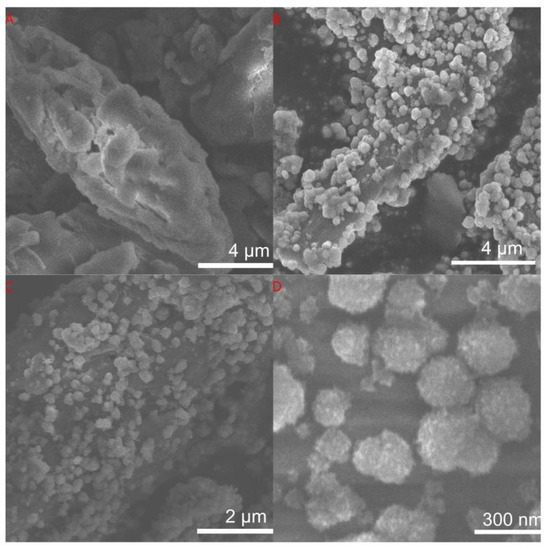
Figure 2.
SEM images of the (A) RH and (B–D) TiO2-2RH.
In Figure 3, FTIR spectra of RH and TiO2-RH composite are presented. Vibration absorption band of TiO2-RH composite between 1400 and 450 cm−1 belongs to characteristic mode of TiO2. The bands at 610 and 1390 cm−1 are ascribed to Ti−O and Ti−O−Ti stretching, respectively [11,12,13]. Strong −OH stretching (3300–3500 cm−1) in TiO2 and TiO2-RH composite may be due to the adsorbed water [12]. FT-IR spectrum of RH presents a vibrational band at 2916 cm−1, which is assigned to C−H stretching; while the band at 1628 cm−1 is indexed to C=C stretching. The band between 1387–1016 cm−1 may be caused by C−O stretching and C=C bending, and such vibrational peaks mostly belong to cellulose, lignin, and biopolymers [11].
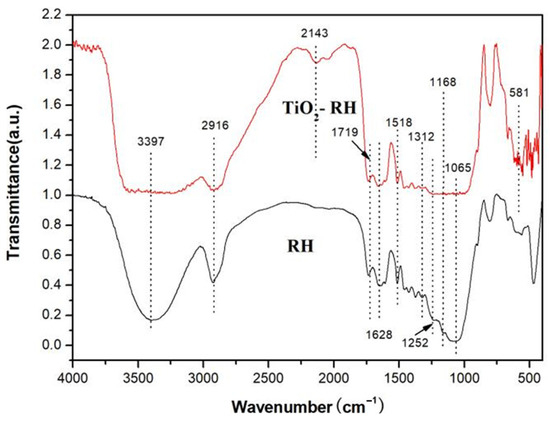
Figure 3.
FTIR spectra of RH and TiO2-RH.
In Figure 4, both the specific surface area and pore volume of the synthesized TiO2-RH composite increase, while the average pore-size decreases. In other words, the improvement of the catalytic performance of the composite is also related to the increase in the specific surface area, as shown in Table 1.
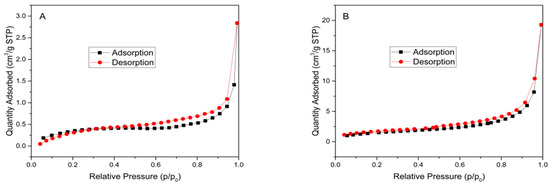
Figure 4.
Adsorption-desorption profiles of (A) RH and (B) TiO2-RH.

Table 1.
Surface parameters of RH and TiO2-RH.
In addition, we conducted XPS measurements on the TiO2-RH composite. In Figure 5, it can be seen that there are mainly titanium, carbon, oxygen, iron, and other elements in the composite. In the Ti 2p spectrum, the peaks at 458.9 and 464.2 eV correspond to Ti 2p3/2 and Ti 2p1/2, respectively, which further verifies the existence of Ti4+ oxidation state in TiO2-RH. According to Figure 5C, C-O-Ti exists in TiO2-RH composite, which proves that TiO2 crystal and RH are combined in the form of chemical bond. The two peaks of the O 1s at 530.2 and 532.4 eV correspond to lattice oxygen and C−O in RH. Figure 5E shows the presence of an oxide of Fe, which may be introduced by the shredder during rice-husk shredding [27,28].
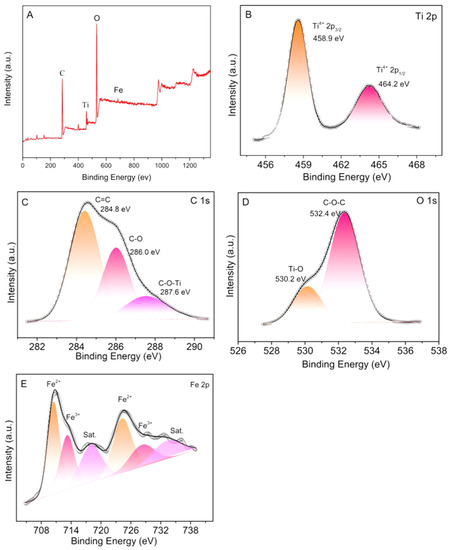
Figure 5.
XPS spectra of the TiO2-RH composite: (A) Survey spectrum, (B) Ti 2p, (C) C 1s, (D) O 1s, and (E) Fe 2p.
Figure 6A shows the UV-vis absorption spectrum of TiO2-RH composite. As expected, the characteristic peak of TiO2 nanocrystals is around 400 nm, and there is almost no absorption of light higher than 400 nm. However, it is interesting to note that the TiO2-RH composite exhibits an unusual UV-visible absorption when the TiO2 is loaded on RH. The UV-vis absorption peak of the TiO2-RH composite has a redshift relative to the TiO2 nanoparticles. Moreover, the amount of RH also affects the optical properties of TiO2-RH. Wavelength of light absorbed by the composite almost covers the entire UV-visible region. This phenomenon is consistent with the optical properties of carbon-doped anatase TiO2. TiO2-RH composite can absorb more light than single TiO2 nanoparticles, indicating that the composite would be able to improve the absorption of visible light, which may also change the process of generating electron-hole pairs in visible light [13]. On the basis of these mechanism, this unique structure of TiO2-RH composite exhibits an improved photocatalytic activity in visible light. Figure 6B shows that the band-gap energy of TiO2-RH composite is lower than that of pure TiO2, which may be related to the combination of TiO2 and rice husk in the composite system [25,28].
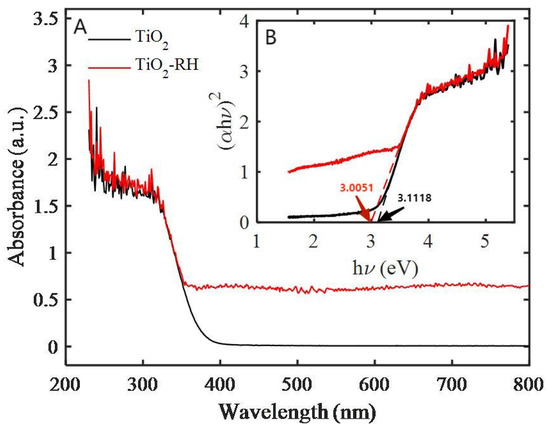
Figure 6.
(A) UV–vis absorption spectra, (B) Tauc’s profile for the band-gap determination.
The degradation of MO by TiO2 and TiO2-RH composites under visible light was investigated, as displayed in Figure 7A. TiO2 without RH exhibits a weak photocatalytic activity and degradation rate of MO after 3 h is about 43%. Pure RH displays no capability of photodegradation. In contrast, for the TiO2-RH samples with RH = 0.5, 1.0, 1.5, 2.0, and 2.5 g, the degradation rates are 69.4%, 87.4%, 86.2, 92.6%, and 90.3%, respectively. With a small amount of RH, the low catalytic activity is ascribed to the accumulation of TiO2 nanoparticles on the surface of RH, which are not well dispersed. Depending on the increase of RH content, the catalytic activity is improved. However, if the amount of RH increases further, the decrease in photocatalytic activity may be caused by the decrease in TiO2 content in the composite. The catalytic performance of TiO2-RH composite is improved compared with TiO2 under visible light; this may be because TiO2-RH composite has a certain light absorption in visible light region, while TiO2 has very less absorption in visible light. As can be seen from the XPS spectrum, the existence of C-O-Ti bond in TiO2-RH composite indicates that TiO2 and RH are combined by chemical bond, rather than van der Waals force, which is more conducive to the separation and transmission of electrons. With the increase of RH amount, the catalytic performance is enhanced, possibly because TiO2 is more dispersed on the RH surface rather than agglomeration. When the amount of RH reaches 2 g, the catalytic performance is the highest. If the amount increases continuously, the catalytic performance decreases, possibly because the amount of active TiO2 catalyst is reduced. TiO2 crystals synthesized by co-precipitate method are spherical in shape, and the binding with RH is in the form of C-O-Ti. Therefore, the key factor affecting the catalytic performance would be the effective dispersion of TiO2 on the surface of RH. In the prepared TiO2-RH, it exhibits a reduced agglomeration, which enables a good catalytic performance compared to the pure TiO2 nanoparticles [29].

Figure 7.
(A) Photodegradation kinetics of TiO2-RH towards 20 mg L−1 MO solution in visible light. (B) Cycling photodegradation of MO by TiO2-2RH under visible light.
Figure 7B shows TiO2-2RH composite cyclically degrading MO (20 mg L−1) in visible light for 180 min per cycle. The catalytic activity of the composite is not significantly reduced after 6 cycles, and it still reaches 81% after 6 cycles. The decrease in the activity of the photocatalyst may be due to the partial shedding of the loaded TiO2 nanoparticles.
4. Conclusions
In summary, a composite based on RH loading with dense TiO2 nanoparticles is developed by a co-precipitation method. The developed preparation method is quite simple. Low-temperature one-step approach for preparing anatase TiO2 reduces the preparation cost, which is significant for potential applications. TiO2 photocatalyst has many applications in the treatment of exhaust gases; however, it is restricted due to the potential biotoxicity when the particle-size is non-ideal. In our study, the particle-size is able to be controlled easily at around 100 to 300 nm which has been considered has a low biotoxicity for use. Moreover, the TiO2-RH developed here displays a high photocatalytical performance due to the suitable particle-size the good dispersibility. The composite shows a good potential in the photocatalytic degradation of MO in visible light. The results show that 92% of MO can be degraded within three hours in visible light. A good cycling photodegradation performance for six rounds is also achieved. It is expected that some other highly-efficient TiO2 composite photocatalysts can also be obtained from agricultural biowastes, such as straw, wheat bran, corn cobs, and sawdust. This work converts agricultural biomass waste into a high-performance photocatalyst, and exhibits a promising application for in wastewater treatment. In addition, it is considered that the degradation efficiency of TiO2 under visible light would be further improved by doping metal ions and introducing single-atom catalyst, which would be promising research directions.
Author Contributions
Methodology, Y.L.; validation, Z.L.; formal analysis, Y.L., X.L., Z.L. and J.L.; writing—original draft preparation, Y.L., X.L., Z.L. and J.L.; writing—review and editing, Z.L. and J.L.; supervision, Z.L. and J.L. All authors have read and agreed to the published version of the manuscript.
Funding
This research work was funded by the Key Research and Development Program of Wuhu (2022YF53) and the Foundation of Anhui Laboratory of Molecule-Based Materials (FZJ21012).
Institutional Review Board Statement
Not applicable.
Informed Consent Statement
Not applicable.
Data Availability Statement
Not applicable.
Conflicts of Interest
The authors declare no conflict of interest.
References
- Kaur, K.; Badru, R.; Singh, P.P.; Kaushal, S. Photodegradation of organic pollutants using heterojunctions: A review. J. Environ. Chem. Eng. 2020, 8, 103666. [Google Scholar]
- AlAbdulaal, T.H.; Ganesh, V.; AlShadidi, M.; Hussien, M.S.A.; Bouzidi, A.; Algarni, H.; Zahran, H.Y.; Abdel-wahab, M.S.; Yahia, I.S.; Nasr, S. The auto-combustion method synthesized Eu2O3-ZnO nanostructured composites for electronic and photocatalytic applications. Materials 2022, 15, 3257. [Google Scholar] [CrossRef] [PubMed]
- Gaya, U.I.; Abdullah, A.H. Heterogeneous photocatalytic degradation of organic contaminants over titanium dioxide: A review of fundamentals, progress and problems. J. Photochem. Photobiol. C Photochem. Rev. 2008, 9, 1–12. [Google Scholar] [CrossRef]
- Hussien, M.S.A.; Bouzidi, A.; Abd-Rabboh, H.S.M.; Yahia, I.S.; Zahran, H.Y.; Abdel-wahab, M.S.; Alharbi, W.; Awwad, N.S.; Ibrahim, M.A. Fabrication and characterization of highly efficient as-synthesized WO3/graphitic-C3N4 nanocomposite for photocatalytic degradation of organic compounds. Materials 2022, 15, 2482. [Google Scholar] [CrossRef] [PubMed]
- Zhang, M.; Wang, Q.; Chen, C.; Zang, L.; Ma, W.; Zhao, J. Oxygen atom transfer in the photocatalytic oxidation of alcohols by TiO2: Oxygen isotope studies. Angew. Chem. Int. Ed. 2009, 48, 6081–6084. [Google Scholar] [CrossRef]
- Ulfa, M.; Afif, H.A.; Saraswati, T.E.; Bahruji, H. Fast removal of methylene blue via adsorption-photodegradation on TiO2/SBA-15 synthesized by slow calcination. Materials 2022, 15, 5471. [Google Scholar] [CrossRef]
- Dou, Q.Q.; Teng, C.P.; Ye, E.; Loh, X.J. Effective near-infrared photodynamic therapy assisted by upconversion nanoparticles conjugated with photosensitizers. Int. J. Nanomed. 2015, 10, 419–432. [Google Scholar]
- Liao, G.Z.; Chen, S.; Quan, X.; Chen, H.; Zhang, Y.B. Photonic crystal coupled TiO2/ polymer hybrid for efficient photocatalysis under visible light irradiation. Environ. Sci. Technol. 2010, 44, 3481–3485. [Google Scholar] [CrossRef]
- Nsib, M.F.; Hajji, F.; Mayoufifi, A.; Moussa, N.; Rayes, A.; Houas, A. In situ synthesis and characterization of TiO2/HPM cellulose hybrid material for the photocatalytic degradation of 4-NP under visible light. Comptes Rendus Chim. 2014, 17, 839–848. [Google Scholar] [CrossRef]
- Virkutyte, J.; Jegatheesan, V.; Varma, R.S. Visible light activated TiO2/microcrystalline cellulose nanocatalyst to destroy organic contaminants in water. Bioresour. Technol. 2012, 113, 288–293. [Google Scholar] [CrossRef]
- Hun, X.; Chen, Y.L.; Liu, P.; Qian, Q.R.; Luo, Y.J.; Cui, M.L.; Chen, Y.S.; Yang, D.P.; Chen, Q.H. Visible light-assisted efficient degradation of dye pollutants with biomass-supported TiO2 hybrids. Mater. Sci. Eng. C. 2018, 82, 197–203. [Google Scholar]
- Alghamdi, Y.G.; Balu, K.K.; Maqsood, A.M.; Sultan, A. Design and preparation of biomass-derived activated carbon loaded TiO2 photocatalyst for photocatalytic degradation of reactive red 120 and ofloxacin. Polymers 2022, 14, 880. [Google Scholar] [CrossRef]
- Alsaiari, M. Biomass-derived active carbon (AC) modified TiO2 photocatalyst for efficient photocatalytic reduction of chromium (VI) under visible light. Arab. J. Chem. 2021, 14, 103258. [Google Scholar] [CrossRef]
- Darwish, A.A.A.; Rashad, M.; Al-Aoh, H.A. Methyl orange adsorption comparison on nanoparticles: Isotherm, kinetics, and thermodynamic studies. Dyes Pigment. 2019, 160, 563–571. [Google Scholar] [CrossRef]
- Zou, Y.P.; Yang, T.K. Rice husk, rice husk ash and their applications. In Rice Bran and Rice Bran Oil; AOCS Press: Urbana, IL, USA, 2019; pp. 207–246. [Google Scholar]
- Priya, A.K.; Yogeshwaran, V.; Rajendran, S.; Hoang, T.K.A.; Soto-Moscoso, M.; Ghfar, A.A.; Bathula, C. Investigation of mechanism of heavy metals (Cr6+, Pb2+ & Zn2+) adsorption from aqueous medium using rice husk ash: Kinetic and thermodynamic approach. Chemosphere 2022, 286, 131796. [Google Scholar]
- Li, A.; Xie, H.; Qiu, Y.; Liu, L.; Lu, T.; Wang, W.; Qiu, G. Resource utilization of rice husk biomass: Preparation of MgO flake-modified biochar for simultaneous removal of heavy metals from aqueous solution and polluted soil. Environ. Pollut. 2022, 310, 119869. [Google Scholar] [CrossRef]
- Tian, J.; Zhao, Z.H.; Kumar, A.; Boughton, R.I.; Liu, H. Recent progress in design, synthesis, and applications of one-dimensional TiO2 nanostructured surface heterostructures: A review. Chem. Soc. Rev. 2014, 43, 6920–6937. [Google Scholar] [CrossRef]
- Liu, X.Y.; Steven, M.Z.; Liu, G.Q.; Li, Y.Q.; Zhang, R.H. Pretreatment of wheat straw with potassium hydroxide for increasing enzymatic and microbial degradability. Bioresour. Technol. 2015, 185, 150–157. [Google Scholar] [CrossRef]
- Ye, E.; Regulacio, M.D.; Bharathi, M.S.; Pan, H.; Lin, M.; Bosman, M.; Win, K.Y.; Ramanarayan, H.; Zhang, S.Y.; Loh, X.J.; et al. An experimental and theoretical investigation of the anisotropic branching in gold nanocrosses. Nano 2016, 8, 543–552. [Google Scholar] [CrossRef]
- Huang, K.; Dou, Q.; Loh, X.J. Nanomaterial mediated optogenetics: Opportunities and challenges. RSC Adv. 2016, 6, 60896–60906. [Google Scholar] [CrossRef]
- Li, Z.; Ye, E.; Lakshminarayanan, D.R.; Loh, X.J. Recent advances of using hybrid nanocarriers in remotely controlled therapeutic delivery. Small 2016, 12, 4782–4806. [Google Scholar] [CrossRef] [PubMed]
- Liu, S.; Sun, X.; Li, J.G.; Li, X.; Xiu, Z.; Yang, H.; Xue, X. Fluorine-and iron-modified hierarchical anatase microsphere photocatalyst for water cleaning: Facile wet chemical synthesis and wavelength-sensitive photocatalytic reactivity. Langmuir 2009, 26, 4546–4553. [Google Scholar] [CrossRef] [PubMed]
- Renwick, L.C.; Brown, D.; Clouter, A.; Donaldson, K. Increased inflammation and altered macrophage chemotactic responses caused by two ultrafine particle types. Occup. Environ. Med. 2004, 61, 442–447. [Google Scholar] [CrossRef] [PubMed]
- Alosaimi, E.H.; Alsohaimi, I.H.; Dahan, T.E.; Chen, Q.; Younes, A.A.; El-Gammal, B.; Melhi, S. Photocatalytic degradation of methylene blue and antibacterial activity of mesoporous TiO2-SBA-15 nanocomposite based on rice husk. Adsorp. Sci. Technol. 2021, 1, 9290644. [Google Scholar] [CrossRef]
- Wang, W.; Hu, C.; Fang, J.J.; Min, L. Large-scale preparation of rice-husk-derived mesoporous SiO2@ TiO2 as efficient and promising photocatalysts for organic contaminants degradation. Appl. Surf. Sci. 2019, 467, 1187–1194. [Google Scholar] [CrossRef]
- Adrian, C.M.L.; Suzana, Y.; Man, K.L.; Bridgid, L.F.C.; Muhammad, S.; Ayaka, Y.; Menandro, N.A. The effect of industrial waste coal bottom ash as catalyst in catalytic pyrolysis of rice husk for syngas production. Energy Convers. Manag. 2018, 165, 541–554. [Google Scholar]
- Fatimah, I.; Said, A.; Hasanah, U.A. Preparation of TiO2-SiO2 using rice husk ash as silica source and the kinetics study as photocatalyst in methyl violet decolorization. Bull. Chem. React. Eng. Catal. 2015, 10, 43–49. [Google Scholar] [CrossRef]
- Faiz, M.A.; Azurahanim, C.C.; Yazid, Y.; Suriani, A.B.; Ain, M.S.N. Preparation and characterization of graphene oxide from tea waste and it’s photocatalytic application of TiO2/graphene nanocomposite. Mater. Res. Express 2020, 7, 015613. [Google Scholar] [CrossRef]
Publisher’s Note: MDPI stays neutral with regard to jurisdictional claims in published maps and institutional affiliations. |
© 2022 by the authors. Licensee MDPI, Basel, Switzerland. This article is an open access article distributed under the terms and conditions of the Creative Commons Attribution (CC BY) license (https://creativecommons.org/licenses/by/4.0/).